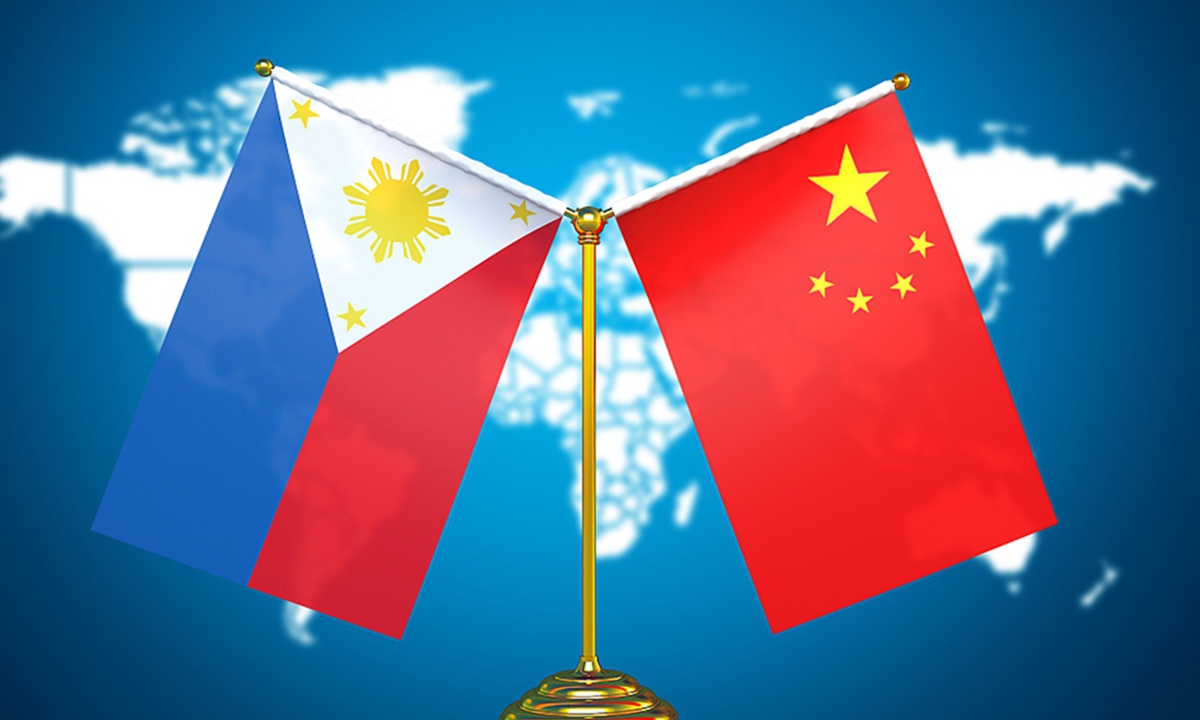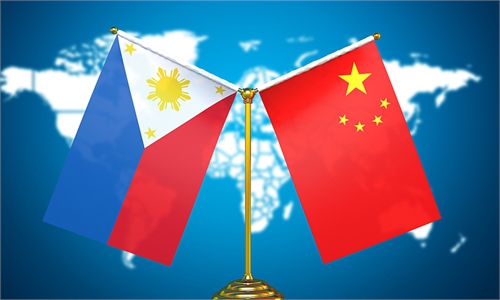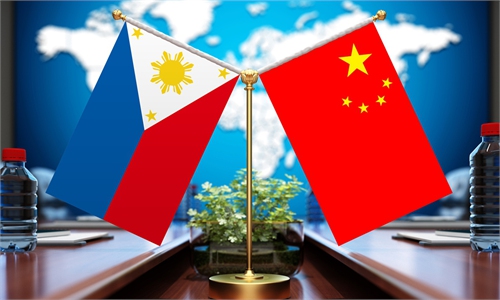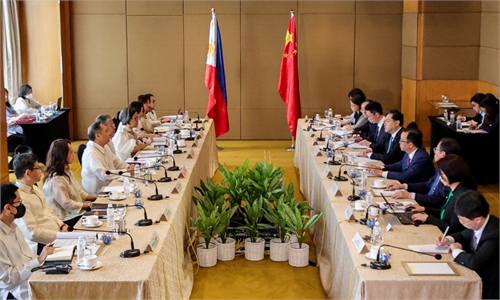
Photo: VCG
The visit of Chinese State Councilor and Foreign Minister Qin Gang to the Philippines from Friday to Sunday at the invitation of Philippine Foreign Secretary Enrique Manalo is timely given the current tense and stiff political relations between the Philippines and China over the expanded Enhanced Defense Cooperation Agreement (EDCA) and tensions over the South China Sea (SCS).
It can be noted that under the current administration of President Ferdinand Marcos Jr., the Philippine government is granting the US entry and passage to install and construct additional four US military bases on top of the existing five US military bases under the EDCA. Of three of the four identified EDCA sites are located in the Northern Luzon, namely, (i) Naval Base, Camilo Osias, Santa Ana, Cagayan; (ii) Lal-lo Airport, Cagayan; and (iii) Camp Melchor Dela Cruz, Gamu, Isabela. These EDCA sites are near and facing the Taiwan Straits, a few hundred kilometers away from Taiwan. The other identified site is Balabac Island of Palawan, near and facing the SCS.
Given the sensitivity of the Taiwan question and the dispute over the SCS, setting up US military installations/infrastructures in the identified additional four EDCA sites seems provocative and rabble-rousing vis-à-vis China concerning the Taiwan question and the "one-China" policy. China has raised concerns about the expanded EDCA and expressed its anxiety, which is a potent source of strain on the political relations between the two countries.
Nevertheless, it is not only the expansion of EDCA that is worrisome and fueling political tensions between the two sides but also the deployment of US boots on Philippine soil, the prepositioning of US military assets, the expected joint patrol between the US and the Philippines in the SCS, and the on-going "Balikatan Exercise 2023," which is thus far the most extensive joint military exercises between the American and Filipino troops.
Furthermore, it can be noted that just earlier this month, the Joint Statement of the Philippines and the US 2+2 Ministerial Dialogue was another source of tension between the Philippines and China, and even between the US and China. In this meeting, US Secretary of Defense Lloyd Austin and Secretary of State Antony Blinken met with their Philippine counterparts, Foreign Secretary Manalo and Senior Undersecretary and Officer in Charge of National Defense Carlito Galvez Jr. in Washington in a high-level summit, days after the US secured greater military entry in the Philippines through the expanded EDCA. During this summit, based on an article published on April 11 in Voice of America entitled "US, Philippines Agree to Finish Security Road Map Within 10 Years," Austin said the long-time allies discussed the delivery of "priority defense platforms," including radars, drones, military transport aircraft, and coastal and air defense systems. The same article also stated that "experts, including former US defense officials, say the United States sees the Philippines as a potential location for rockets, missiles and artillery systems to counter a Chinese amphibious invasion of Taiwan, which China claims as its own."
Indeed, against this backdrop, the Philippines-China political relationship has been somewhat under strain. Hence, the visit of Qin is a positive step and development in an attempt to alleviate tensions and to extinguish the fire, to bridge mutual understanding on the differences and conflict of interests between the two sides.
As per the press release from the Department of Foreign Affairs, the top diplomats of the two countries have exchanged views on the outcomes of the Philippines-China Foreign Ministry Consultations and Bilateral Consultations Mechanism on the South China Sea held in March. Both sides discussed how to implement the agreements reached at the highest levels during leaders' meeting on January 4. The two diplomats pledged to work together to resolve their maritime differences in the SCS. Expectedly, the two sides likewise discussed how to move forward in forging more profound, strong, and extensive cooperation in agriculture, trade, energy, infrastructure, and people-to-people relations, among others. Furthermore, the two countries' top diplomats have tackled regional security issues of mutual concern that affect the region.
As Qin embarked on an official visit to the Philippines, the White House announced via a press release that Philippine President Marcos Jr. is about to embark on a five-day official visit to the US. Media reports state that US President Joe Biden will welcome Marcos Jr. to the White House on May 1. According to White House Press Secretary Karine Jean-Pierre, "During the visit, President Biden will reaffirm the US iron-clad commitment to the defense of the Philippines, and the leaders will discuss efforts to strengthen the longstanding US-Philippines alliance."
On this note, in anticipation of the upcoming meeting between Marcos Jr. and Biden, more likely, Washington will further draw the Philippines closer within its sphere of influence, particularly with the ambit of its security, defense, and military architecture in the Indo/Asia Pacific region, towing and luring the Philippines deeper into not only the "militarization of the South China Sea" and unsettling the status quo in the Taiwan Straits but even the militarization of the Philippines itself.
In this regard, amid the intensifying major power competition and geopolitical rivalry between the US and China, more specifically in the Indo-Pacific region, putting into consideration the plight of the Taiwan Straits, it is imperative to ask the questions of how should the Philippines develop a positive and stable relationship with China? How should the Philippines respond to the US provocations in a zero-sum game, and how should the Philippines insulate itself from the ongoing tug-of-war between the declining superpower and the rising superpower in Asia and beyond?
The answer to these questions is not rocket science or new, for it has been done before under the previous administration of former president Rodrigo Duterte. The Philippines should pursue a genuine and meaningful independent foreign policy with peace and neutrality as core values that uphold and prioritize its supreme national interests. Like other member states of ASEAN, the Philippines must avoid taking sides at all costs. It must not be subservient to the will and caprices of any superpower.
Likewise, it should terminate the EDCA, especially the additional four EDCA sites, to soothe China's concern and anxiety that the US may use those new sites in its forward military operations in the Indo-Pacific region if, in any case, a war or military confrontation breaks out between the US and China in the Taiwan Straits.
Most importantly, the administration of President Marcos Jr. should avoid the so-called strategic ambiguity that the US practices in relation to the "one-China" policy, in which the US says one thing and does another. The Philippines must not imitate and avoid at all costs the US practice of strategic ambiguity, also known as a policy of strategic uncertainty of being intentionally ambiguous on specific aspects of US foreign policy that suit its geostrategic and hegemonic interests at the expense of others, which, in short, bluntly means that US foreign policy toward the Taiwan question vis-à-vis the "one-China" principle is akin to a "two-faced" foreign policy loaded with double standards and double talks.
In retrospect, as a country, the Philippines should have a firm resolve and tenacity to deviate from the "colonial mentality" of being subservient to the US, veering away from being used as a pawn in the US hardline policy and posture against China, which if not tempered and moderated will only lead to horrendous misadventure and tragedy endangering the relative peace and stability of the Asia Pacific region. The Philippines should not compromise itself for the geopolitical interests and agenda of the US in containing China's rise to preserve its hegemony in the world.
Also, the expanded EDCA, the prepositioning of US military assets, and the deployment of more US troops on Philippine soil will not only militarize the Philippines but might also provoke the militarization of the ASEAN region and the wider Asia-Pacific. EDCA expansion could propel an arms race in the region too. Likewise, EDCA expansion and EDCA itself are not and will never be stabilizing and deterrent factors for maintaining peace and stability in the ASEAN region, particularly in the Philippines. Rather, EDCA bases are magnates for military conflict and arms race in ASEAN and East Asia. EDCA bases are like circuit breakers or electrical fuses that can prompt miscalculations on the ground; these EDCA bases can flare up into flames stirring conflict in East Asia, the ASEAN region, and the wider Indo/Asia-Pacific region. Thus, the Philippines must do away with the expanded EDCA or EDCA itself.
The author is a senior research fellow of Global Governance Institution, and vice president of External Affairs of the Asian Century Philippines Strategic Studies Institute. opinion@globaltimes.com.cn



